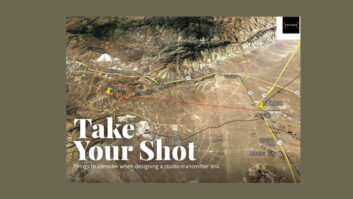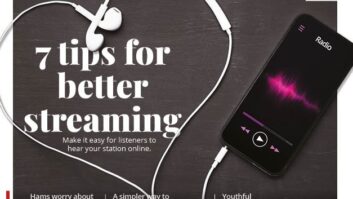LOS ANGELES Classical music has a tough time surviving in today’s radio market, especially in Los Angeles, which offers 50 stations representing virtually all the major radio formats.
Yet public station KUSC(FM) at 91.5 MHz is beating the odds and celebrating with new studios, a stronger broadcast signal and a satellite network.
Chief Engineer Pablo Garcia guided the station’s equipment upgrade and its move from a cramped 7,700 square feet on the campus of the station’s licensee, the University of Southern California, to 16,100 square feet on two floors of an office building in the heart of downtown Los Angeles.
From Cuba to L.A.
Garcia is as much a success story as KUSC. In 1961, his family escaped from Cuba with just the clothes on their backs and Cuba’s international currency, cigars. Garcia was 12 years old and didn’t speak English. One of his earliest memories is of his father selling the cigars at an upscale hotel in Miami.
(click thumbnail)Pablo Garcia
Garcia graduated from California State University in Northridge and joined KUSC in 1987, rising from assistant to chief engineer. He moved to all-news KFWB(AM) in 1997, after KUSC’s management implemented a controversial programming change that was followed by diminishing listenership and layoffs.
Two years later, the university hired Brenda Barnes, former president and general manager of WGUC(FM) in Cincinnati, as station manager. She returned the station to its classical programming and brought Garcia back to guide a relocation to new facilities and oversee an equipment upgrade from analog to digital.
For the new facilities, Barnes gave Garcia a clean slate and asked him to create a station that could handle the growth and the development of a satellite network. The budget for the technical upgrade was set at $500,000.
Garcia’s goal for the station’s operation was to have a digital system automated on a 24/7 basis. The old system used an analog console, CD and DAT players.
“There was still this constant D-to-A conversion,” Garcia said. “The actual microwave we shot to our mountain transmitter was also analog. It was a case of bits and pieces mixed together.”
Garcia replaced those pieces with a seamless digital chain from the studio to the transmitter. Starting with voice tracking, he specified two tracking studios with Yellowtec Intellimix Digital consoles.
“They’re just for people to basically go in there and track,” Garcia said, “no production, just voice. It’s working out really well.”
An additional interview studio can accommodate six people and has a large window facing the station’s lobby area.
Production
Three production studios are equipped with Harris Pacific Integrity digital consoles, Sony CDP-D500 CD players, Denon M-1050R MiniDisc machines and Telos Zephyr ISDN gear.
Files are handled by a DADpro32 ENCO Systems Digital Audio Delivery system and transferred via a dedicated LAN. The ENCO system is networked throughout the studios and master control. It uses ISO/MPEG Layer II coding.
The station has four workstations and two mirrored servers. A second LAN handles administration, e-mail and Internet activities. In addition to special projects, engineers Garcia and Nisie Teeter manage the computer and network infrastructure, which operates on a Windows NT platform.
(click thumbnail)Lobby visitors can see into the busy conference studio.
The ENCO supports production, automation and programming origination. It has a storage capacity of approximately 30 hours of stereo material, and controls airplay by automatically sending the appropriate commands to an SAS 64000 Digital Audio Router.
“Basically,” Garcia said, “all inputs and outputs of every audio resource including every CD player, console, MD player, ENCO, absolutely everything, gets fed into our SAS switcher and then routed throughout the station.”
The Harris Intraplex STL provides T-1 Internet connectivity to a transmitter on Mt. Harvard, atop the San Gabriel Mountains northeast of Los Angeles. A Harris CD-Link digital STL provides backup connectivity. Both paths are uncompressed.
The RF site uses a Harris Z-20 solid-state 20 kW transmitter and Aphex 2020 Mk II processing. That facility was not part of the project, having been upgraded in 1999.
Classical network
Garcia said the station maintains a consistent sampling rate from all its equipment, so he hasn’t had any problems with synchronizing one digital audio source to another.
Three additional stations in Palm Springs, Santa Barbara and Thousand Oaks, Calif., simulcast via Galaxy IVR satellite, said Garcia. “We also air IDs and promotional announcements. All of these are stored on the ENCO, then aired as scheduled in the traffic log.”
KUSC Hardware ListThis is a sampling of the KUSC infrastructure. Most items listed were purchased new for the project.
Harris Pacific Integrity digital consoles (3) ENCO Systems DADpro32 Digital Audio Delivery system and automation with dual mirrored servers and four workstations SAS 64000 Digital Audio Router Sony CDP-D500 CD players (6) Denon M-1050R MiniDisc player/reproducers (6) Harris Intraplex STL-Plus for T-1 (3) Harris CD-Link Digital STL backup Neumann U-87 mics(6) and TLM-103 mics (2) Belden 7893A and 1800B AES/EBU digital cable for all audio runs and interconnects Yellowtec Intellimix digital mixers for tracking studios (2)
Two LANs: one for office/admin and the ENCO system for broadcast and production
The station’s satellite system, Classical Public Radio Network, is a partnership between KUSC and Colorado Public Radio and provides classical music across the United States.
Eight members of the network’s staff are based at KUSC’s studios. Shows are produced in Los Angeles and Denver. Everything gets funneled via T-1 into CPRN’s Prophet Systems Audio Wizard audio server and automation at KBSU in Boise, Idaho, where the network’s satellite facilities are located.
Garcia wanted all connections and operations hardware centralized in a master control room. Interconnects, basic hardware and hard drives for storage systems, plus computer and telephone systems, are housed in one area.
“This is great compared to the old facility,” Garcia said. “We had three different rooms and it was really difficult to put things together and work.”
In its 55-year history, KUSC had always been located on the University of California campus. But space demands required a move to outside facilities, and the station found favorable lease terms on the 20th and 21st floors of an office building in downtown Los Angeles, minutes from the campus.
Garcia and KUSC management interviewed three architectural firms with broadcasting design experience, and chose Hellmuth, Obata and Kassabaum Inc., an award-winning firm with 22 offices. HOK also is working on two other stations in Los Angeles, KZLA(FM) and KPWR(FM).
Prepared
The designers had good things to say about their client.
“They were really knowledgeable about what they needed and what worked for them,” said Brett Shwery, vice president of the interior division of HOK. “The most important thing was placement of the studios. You have to be careful of the mechanical systems in the building.”
Shwery and his team consulted with KUSC and it was agreed to put the studios on the 20th floor, to avoid complications from heating, ventilation and air conditioning equipment above the 21st. The space on both floors had never been occupied, so wiring and cable installation were simplified.
The Los Angeles-based Victor Group and KUSC engineering staff provided studio wiring and interconnects. Telephone and data wiring were subcontracted out. The design plans took about four months, and construction took another four, ending with a grand opening for the station’s supporters in November 2001.
The studios were placed on interior walls. A complication came from a noisy gear mechanism for a private elevator servicing the offices. To solve the problem, HOK had the mechanism rebuilt with a base isolator.
One wall of the large interview studio borders on the station’s lobby space, and visitors can see the room’s activities through a large window. In fact, a unique floor plan and window placement on walls shared by the studios allows viewing between all six of the rooms. The studios use double-layered dry walls and ceilings, sound lock doors, airshafts and double-paned windows.
Ultimately, Garcia said the digital upgrade provides tremendous quality for the money available to a public radio station.
“I found it much easier to upgrade here rather than at a commercial station,” Garcia said. “At a commercial station, the obligation is to the stockholders; and the less spent on the station, the more returned to them. Our obligation is to the listeners because they pay for the station.”














